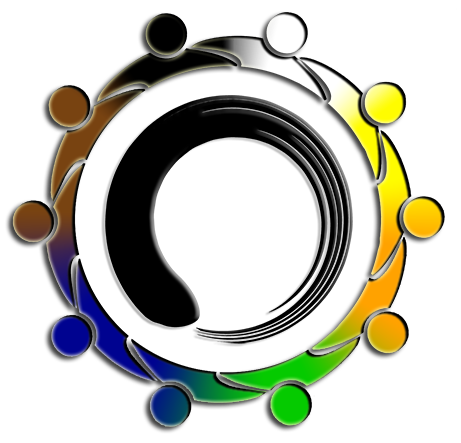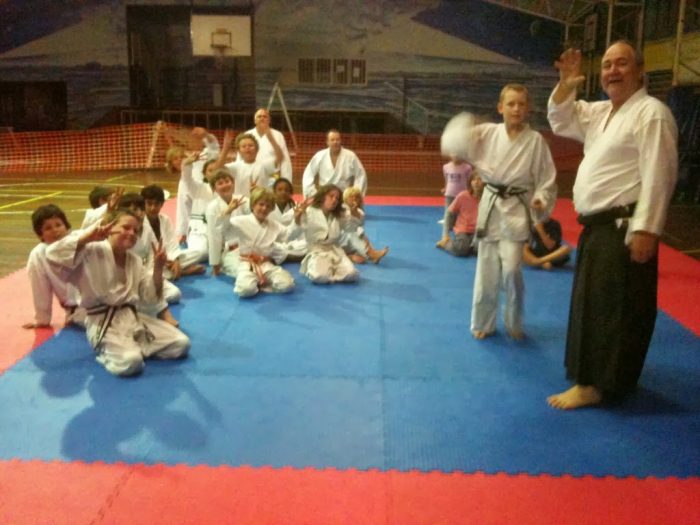About us
We are a friendly social not for profit association conducting Aikido training in Aikido Goshinkai style in the Tweed Heads / Coolangatta area. All visitors are welcome to come along and watch. Visitors from other styles are welcome to train with us. Beginners are welcome to come along at any time and start training, watch or have a talk with the instructors and students.
About our symbol

Our symbol has many meanings…
The centre –
Calm – This is a place of calm where you place yourself. Around you is your dynamic sphere.
Inner circle –
Enso –
ensō (円相, , “circle”) is a circle that is hand-drawn in one or two uninhibited brushstrokes to express a moment when the mind is free to let the body create.
The ensō symbolizes absolute enlightenment, strength, elegance, the universe, and mu (the void). It is characterised by a minimalism born of Japanese aesthetics.
Drawing ensō is a disciplined-creative practice of Japanese ink painting—sumi-e (墨絵, “ink painting”). The tools and mechanics of drawing the ensō are the same as those used in traditional Japanese calligraphy: One uses a brush (筆, fude) to apply ink to washi (a thin Japanese paper).
The circle may be open or closed. In the former case, the circle is incomplete, allowing for movement and development as well as the perfection of all things. Zen practitioners relate the idea to wabi-sabi, the beauty of imperfection. When the circle is closed, it represents perfection, akin to Plato’s perfect form (Plato), the reason why the circle was used for centuries in the construction of cosmological models, see Ptolemy.
Usually, a person draws the ensō in one fluid, expressive stroke. When drawn according to the sōsho (草書) style of Japanese calligraphy, the brushstroke is especially swift. Once the ensō is drawn, one does not change it. It evidences the character of its creator and the context of its creation in a brief, continuous period of time. Drawing ensō is a spiritual practice that one might perform as often as once per day.[1]
This spiritual practice of drawing ensō or writing Japanese calligraphy for self-realization is called hitsuzendō (筆禅道, “way of the brush”). Ensō exemplifies the various dimensions of the Japanese wabi-sabi perspective and aesthetic: Fukinsei (asymmetry, irregularity), kanso (simplicity), koko (basic; weathered), shizen (without pretense; natural), yugen (subtly profound grace), datsuzoku (freedom), and seijaku (tranquility).
Dynamic Sphere –
Aikidoka and their dynamic sphere are the centre of the Aikidoka’s universe around which energy revolves.
Circle –
The symbol depicted is a simple shape, a circle. To go in a bit more detail, a circle is a closed two-dimensional plane curve at which every point is equal distance from the centre.
But why is it significant?
In Ancient Greek culture the circle was thought of as the perfect shape. To the Greeks the circle was a symbol of the divine symmetry and balance in nature. Greek mathematicians were fascinated by the geometry of circles and explored their properties for centuries.
That’s cool… but Greek times were over two millennia ago! Why do you bring this up?
Circles are still symbolically important today – they are often used to symbolise harmony and unity. For instance, take a look at the Olympic symbol. It has five interlocking rings of different colours, which represent the five major continents of the world united together in a spirit of healthy competition. Perhaps you have never stopped to think about them, but circles are everywhere and they really are fascinating as well as beautiful.
Outer circle –
Community –
The logo is essentially a re-drawn ‘Circle of Friends’ (pictured below) placed within a roundel.
This represents our community and extended Aikido community working together to help each other centreing on the Aikido ideals.
Colours –
Starting at the top of the clock and working clockwise these are our belt colours and marks the progression of understanding through the passage of time. Each member is looking to next for understanding and support. The circle continues and has no end with the Black Belt having continued beginners mind they looking towards the White belt.
The different colours also reflects inconclusiveness and welcoming of all people into our community.
Our Lineage
O’Sensei – Morihei Ueshiba – Aikido Founder > Master Koichi Tohei > Michael Williams Sensei
Our Life Members
The granting of Life Membership is a great honour.
Life Membership is reserved for those whose contribution goes beyond the ordinary or even the excellent for an extended period of time.
Sensei Aikido Community life members – In the order of being awarded their life membership –
Mark Albrecht Sensei (Founding member – HDI)
Carl Albrecht
Blake Albrecht (Honorary)
Gary Simpson Sensei (R.I.P.)
Russell O’Conner Sensei
Elisabeth Andel Sensei (Honorary)
Mark Evans Sensei (Honorary)
Michael Williams Sensei (Honorary)
Mark Storrier Sensei
Aaron Smith Sensei (R.I.P.)
Stephen Hicks Sensei
Olivia Albrecht Sensei
Lili Ottaway Sensei
Other Aikido Community life members – In the order of being awarded their life membership –
Julia Chick (Honorary – Founding member)
Jan Hobson (Honorary – Founding member)
Bruce Watson (Honorary – Founding member)
Benjamin Chambers – (Honorary – Founding)
Richard Sweetnam (Honorary)
Ian Edwards (Honorary – Founding member)
Dean Scott (Honorary – Founding member)
Lisa Albrecht
Dan Calandro (Honorary – R.I.P.)
Aikido Community club history
Aikido Community Club is present today due to the roots and backbone established by the initial efforts of Discover Aikido, Bob Liedke Sensei (HDI – Discover Aikido), Sandie Liedke, Mark Albrecht Sensei, Lisa Albrecht and Michael Williams Sensei.
Our Aikido Community Club was formed out of a collection of the willing from the old Discover Aikido club members.
Some of the efforts to be recognised –
Bob Liedke Sensei – for enlightening us to our Aikido path and for giving his blessing on the start of the new club.
Michael Williams Sensei – for enlightening Sensei Bob Liedke to the Aikido path.
For giving his blessing on the start of the new Aikido Community club.
Appointing Sensei Mark Albrecht to Dojo Cho (Head of a training hall).
For approaching other Sensei to help support the club in the Sensei Team.
Giving of Aikido Community financial support via mini seminar.
Raising support within the wider Aikido community.
For founding Aikido Goshinkai and so much more behind the scenes.
Elisabeth Andel Sensei – giving her support in so many ways behind the scenes as well as being our first instructor on opening night and Lead Sensei team member.
Raising support with the wider community.
Helping Sensei Michael Williams founding of Aikido Goshinkai and such much more behind the scenes with Aikido Goshinkai.
Mark Evans Sensei – being one of our Sensei team members and behind the scenes support.
Mark Albrecht Sensei – being one of our Sensei team members and taking on the Dojo Cho (Head of a training hall) Sensei role.
Bruce Watson – who continued to contact all members and Aikido wider community until a consensus was formed.
The Founding Members Julia Chick, Jan Hobson, Bruce Watson, Benjamin Chambers, Ian Edwards, Dean Scott and Mark Albrecht – these members all worked together to submit foundation paperwork, funded the start of this club and supported the members to start the club.
The First Committee Members Julia Chick (President), Jan Hobson (Treasurer), Bruce Watson (Vice President), Benjamin Chambers (Started Term as Secretary), Richard Sweetnam (Finish term as Secretary), Ian Edwards (Member), Dean Scott (Member) and Mark Albrecht Sensei (Special voting invite to help with startup issues) – most of the heavy decision-making and club formation of policies and procedures have been managed by these members.
Jan Hobson - special fund-raising via applying for Grants and setting up the structure to support applying for grants.
The Albrecht Family - supplying the Mats for the club use.
Byron Bay Aikido Club – leading of vital equipment to help the club get started and behind the scenes support.
Steve Mitchell Sensei – inter club visits and behind the scenes support.
There are many people involved and as a clock all pieces are needed to form a functional clock.
Many thanks to all these people..


